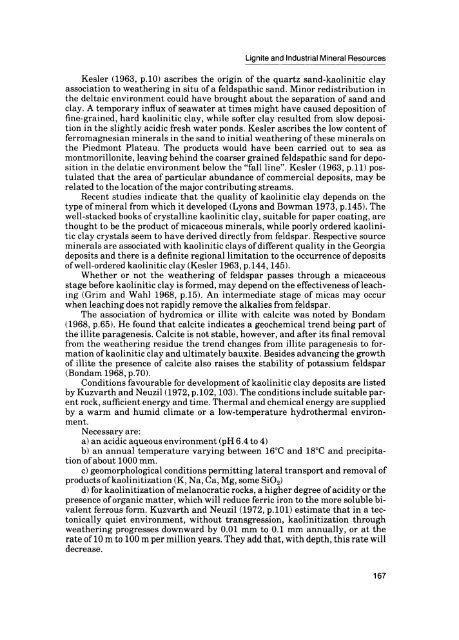Moose River Basin: geology and mineral potential - Geology Ontario
Moose River Basin: geology and mineral potential - Geology Ontario
Moose River Basin: geology and mineral potential - Geology Ontario
You also want an ePaper? Increase the reach of your titles
YUMPU automatically turns print PDFs into web optimized ePapers that Google loves.
Lignite <strong>and</strong> Industrial Mineral Resources<br />
Kesler (1963, p.10) ascribes the origin of the quartz s<strong>and</strong>-kaolinitic clay<br />
association to weathering in situ of a feldspathic s<strong>and</strong>. Minor redistribution in<br />
the deltaic environment could have brought about the separation of s<strong>and</strong> <strong>and</strong><br />
clay. A temporary influx of seawater at times might have caused deposition of<br />
fine-grained, hard kaolinitic clay, while softer clay resulted from slow deposi<br />
tion in the slightly acidic fresh water ponds. Kesler ascribes the low content of<br />
ferromagnesian <strong>mineral</strong>s in the s<strong>and</strong> to initial weathering of these <strong>mineral</strong>s on<br />
the Piedmont Plateau. The products would have been carried out to sea as<br />
montmorillonite, leaving behind the coarser grained feldspathic s<strong>and</strong> for depo<br />
sition in the delatic environment below the "fall line". Kesler (1963, p.11) pos<br />
tulated that the area of particular abundance of commercial deposits, may be<br />
related to the location of the major contributing streams.<br />
Recent studies indicate that the quality of kaolinitic clay depends on the<br />
type of <strong>mineral</strong> from which it developed (Lyons <strong>and</strong> Bowman 1973, p. 145). The<br />
well-stacked books of crystalline kaolinitic clay, suitable for paper coating, are<br />
thought to be the product of micaceous <strong>mineral</strong>s, while poorly ordered kaolini<br />
tic clay crystals seem to have derived directly from feldspar. Respective source<br />
<strong>mineral</strong>s are associated with kaolinitic clays of different quality in the Georgia<br />
deposits <strong>and</strong> there is a definite regional limitation to the occurrence of deposits<br />
of well-ordered kaolinitic clay (Kesler 1963, p. 144,145).<br />
Whether or not the weathering of feldspar passes through a micaceous<br />
stage before kaolinitic clay is formed, may depend on the effectiveness of leach<br />
ing (Grim <strong>and</strong> Wahl 1968, p. 15). An intermediate stage of micas may occur<br />
when leaching does not rapidly remove the alkalies from feldspar.<br />
The association of hydromica or illite with calcite was noted by Bondam<br />
(1968, p.65). He found that calcite indicates a geochemical trend being part of<br />
the illite paragenesis. Calcite is not stable, however, <strong>and</strong> after its final removal<br />
from the weathering residue the trend changes from illite paragenesis to for<br />
mation of kaolinitic clay <strong>and</strong> ultimately bauxite. Besides advancing the growth<br />
of illite the presence of calcite also raises the stability of potassium feldspar<br />
(Bondam 1968, p.70).<br />
Conditions favourable for development of kaolinitic clay deposits are listed<br />
by Kuzvarth <strong>and</strong> Neuzil (1972, p. 102,103). The conditions include suitable par<br />
ent rock, sufficient energy <strong>and</strong> time. Thermal <strong>and</strong> chemical energy are supplied<br />
by a warm <strong>and</strong> humid climate or a low-temperature hydrothermal environ<br />
ment.<br />
Necessary are:<br />
a) an acidic aqueous environment (pH 6.4 to 4)<br />
b) an annual temperature varying between 160C <strong>and</strong> 18 0C <strong>and</strong> precipita<br />
tion of about 1000 mm.<br />
c) geomorphological conditions permitting lateral transport <strong>and</strong> removal of<br />
products of kaolinitization (K, Na, Ca, Mg, some SiO 2)<br />
d) for kaolinitization of melanocratic rocks, a higher degree of acidity or the<br />
presence of organic matter, which will reduce ferrie iron to the more soluble bi<br />
valent ferrous form. Kuzvarth <strong>and</strong> Neuzil (1972, p. 101) estimate that in a tectonically<br />
quiet environment, without transgression, kaolinitization through<br />
weathering progresses downward by 0.01 mm to 0.1 mm annually, or at the<br />
rate of 10 m to 100 m per million years. They add that, with depth, this rate will<br />
decrease.<br />
167

















